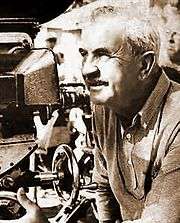Burnett Guffey
| Burnett Guffey, A.S.C. | |
|---|---|
|
Guffey behind the camera | |
| Born |
May 26, 1905 Del Rio, Tennessee, U.S. |
| Died |
May 30, 1983 (aged 78) Goleta, California, U.S. |
| Title | A.S.C. |
| Board member of | A.S.C. President (1957–1958) |
| Awards |
Best Black-and-White Cinematography 1954 From Here to Eternity Best Cinematography 1968 Bonnie and Clyde |
Burnett Guffey, A.S.C. (May 26, 1905 – May 30, 1983) was an American cinematographer.[1]
He won two Academy Awards: From Here to Eternity (1953) and Bonnie and Clyde (1967).
Career
While still a teenager, the future Academy Award-winning cinematographer began as a camera assistant in 1923 on John Ford's 1924 western saga The Iron Horse. He was then hired by the Famous Players-Lasky Studios in 1927, became a camera operator in 1928 and worked there until 1943. Guffey was hired as a Director of Photography by Columbia Pictures in 1944.[2][3]
In 1957–58 he served as president of the American Society of Cinematographers (A.S.C.) for a year, and had been a long-standing member.
According to film critic Spencer Selby, Guffey was a prolific film noir cinematographer, shooting 20 of them, including In a Lonely Place (1950).[4][5]
Filmography
- Love Over Night (1928)
- Fairways and Foul (1929)
- Tahiti Nights (1944)
- The Unwritten Code (1944)
- Kansas City Kitty (1944)
- The Soul of a Monster (1944)
- U-Boat Prisoner (1944)
- Sailor's Holiday (1944)
- My Name Is Julia Ross (1945)
- The Girl of the Limberlost (1945)
- The Gay Senorita (1945)
- The Blonde from Brooklyn (1945)
- Eve Knew Her Apples (1945)
- I Love a Mystery (1945)
- Eadie Was a Lady (1945)
- Gallant Journey (1946)
- So Dark the Night (1946)
- Night Editor (1946)
- A Bird in the Head (1946)
- The Notorious Lone Wolf (1946)
- Meet Me on Broadway (1946)
- A Close Call for Boston Blackie (1946)
- The Fighting Guardsman (1946)
- Framed (1947)
- Johnny O'Clock (1947)
- The Gallant Blade (1948)
- Screen Snapshots: Smiles and Styles (1948)
- Screen Snapshots: Photoplay Gold Medal Awards (1948)
- The Sign of the Ram (1948)
- To the Ends of the Earth (1948)
- And Baby Makes Three (1949)
- All the King's Men (1949)
- The Reckless Moment (1949)
- The Undercover Man (1949)
- Knock on Any Door (1949)
- Emergency Wedding (1950)
- Convicted (1950)
- In a Lonely Place (1950)
- Father Is a Bachelor (1950)
- The Family Secret (1951)
- Two of a Kind (1951)
- Sirocco (1951)
- Assignment – Paris! (1952)
- The Sniper (1952)
- Scandal Sheet (1952)
- From Here to Eternity (1953)
- The Last Posse (1953)
- The Bamboo Prison (1954)
- Private Hell 36 (1954)
- Human Desire (1954)
- Three Stripes in the Sun (1955)
- Count Three and Pray (1955)
- Tight Spot (1955)
- The Violent Men (1955)
- Storm Center (1956)
- The Harder They Fall (1956)
- Battle Stations (1956)
- Decision at Sundown (1957)
- The Brothers Rico (1957)
- The Strange One (1957)
- Nightfall (1957)
- Me and the Colonel (1958)
- Screaming Mimi (1958)
- The True Story of Lynn Stuart (1958)
- Edge of Eternity (1959)
- They Came to Cordura (1959)
- Gidget (1959)
- Let No Man Write My Epitaph (1960)
- Hell to Eternity (1960)
- The Mountain Road (1960)
- Mr. Sardonicus (1961)
- Homicidal (1961)
- Cry for Happy (1961)
- Kid Galahad (1962)
- Birdman of Alcatraz (1962)
- Good Neighbor Sam (1964)
- Flight from Ashiya (1964)
- King Rat (1965)
- The Silencers (1966)
- The Ambushers (1967)
- Bonnie and Clyde (1967)
- How to Succeed in Business Without Really Trying (1967)
- The Split (1968)
- The Madwoman of Chaillot (1969)
- Some Kind of a Nut (1969)
- The Learning Tree (1969)
- Where It's at (1969)
- Halls of Anger (1970)
- The Great White Hope (1970)
- Suppose They Gave a War and Nobody Came (1970)
- The Steagle (1971)
Awards
Wins
- Academy Awards: Oscar, Best Cinematography, Black-and-White, for From Here to Eternity; 1954.
- Academy Awards: Oscar, Best Cinematography, for Bonnie and Clyde; 1968.
Nominations
- Golden Globes: Golden Globe, Best Cinematography, Black and White, for All the King's Men; (1950)
- Academy Awards: Oscar, Best Cinematography, Black-and-White, for The Harder They Fall, (1957).
- Academy Awards: Oscar, Best Cinematography, Black-and-White, for Birdman of Alcatraz, 1963.
- Academy Awards; Oscar, Best Cinematography, Black-and-White, for King Rat; 1966.
References
- ↑ Burnett Guffey at the Internet Movie Database.
- ↑ Burnett Guffey at AllMovie.
- ↑
- Steeman, Albert. Internet Encyclopedia of Cinematographers, "Burnett Guffey page," Rotterdam, The Netherlands, 2007. Last accessed: January 2, 2008.
- ↑ Selby, Spencer. Dark City: The Film Noir, page 239, 1984. Jefferson, NC: McFarland & Company, Inc., Publishers.
- ↑ American Society of Cinematographers Archived July 15, 2007, at the Wayback Machine.. "Lonely America: The Noir Cinematography of Burnett Guffey ASC," 2007. Last accessed: January 2, 2007.
External links
- Burnett Guffey at the Internet Movie Database
- Burnett Guffey at AllMovie
- Burnett Guffey at the TCM Movie Database

- Burnett Guffey at Film Reference
- Film Noirs photographed by Burnett Guffey
- Burnett Guffey: four film trailers at Spike TV (iFilm)
